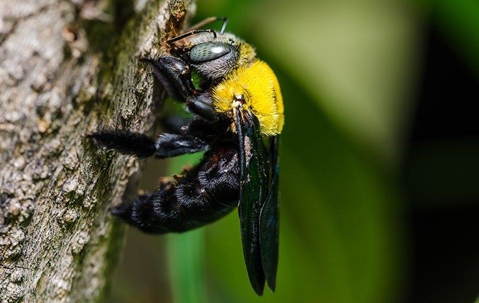When dealing with bees, it is important to realize that they are not all created equal and this is especially true when referring to the carpenter bee! Carpenter bees, while similar in appearance to other bee species, do not behave in the way that you would usually associate bees with; they aren’t aggressive, don’t live together in large colonies, and aren’t beneficial to the environment like honey bees. Instead, these bees have wood-damaging habits. To help you protect your home from being damaged by these destructive bees, here is some helpful information about carpenter bees.
Carpenter Bee Identification
Carpenter bees are a larger species of bee that grow to be about an inch long. They look very similar to the bumble bee, except for the fact that carpenter bees are mostly black instead of black and yellow and instead of being fuzzy, their abdomens are shiny and bare. Male carpenter bees are very aggressive and will attack anything they view as a threat, but don’t worry: they aren’t equipped with a stinger; the females, on the other hand, have stingers but are very docile and rarely sting.
Unlike most species of bees, carpenter bees are solitary insects, meaning that each of the females create their own nest inside wooden structures instead of nesting together. To create their nests, the females create round, dime-sized holes in wooden structures and then tunnel through the wood. Carpenter bees prefer to create their nests in older structures that are made of softwood and aren’t painted or stained – structures that are commonly invaded by carpenter bees include decks, porches, wooden playhouses, wooden garden sheds, wooden outdoor furniture, sheds, wooden trim, and wooden playsets.
Facts About Carpenter Bees
While one carpenter bee nesting on your property probably isn’t a big deal, a large infestation can result in a lot of damage to your home. The following facts about carpenter bees explain why their damages can become so significant:
- Females return to the same nesting sites year after year, increasing the size of their nests and creating more and more damages.
- Females each create their own nest, but many females may choose the same piece of wood or area to create their nests in, resulting in more damage to that area.
- Woodpeckers love to feed on carpenter bee larvae; they are attracted to the sounds of the larvae hatching from their eggs and will peck at the entrance of the nest to gain access to them, creating even more unsightly damage to the piece of wood the nest is located in.
Eradicated Carpenter Bees With Professional Home Pest Control
One of the best ways to help deter carpenter bees from choosing your property to nest on is to make sure that all the wooden surfaces on your property have been finished with stain or paint; carpenter bees do not like to have to carve their way through pieces of sealed wood. When building structures on your property, it is also helpful to choose a hardwood rather than a softwood that carpenter bees prefer to nest in. To prevent attracting carpenter bees to your property in the first place, remove any piles or pieces of decaying wood from your property, including fallen trees.
If you discover that carpenter bees have taken up residence on your property, contact the stinging insect control professionals at Innovative Pest Control! Our professionals will inspect your property, find all the nesting sites, provide treatment, and implement the preventative services needed to prevent their return. To learn more about how Innovative Pest Control can help eliminate carpenter bees from your property, give us a call today!
Categories:
- Carpenter Bee Prevention,
- Carpenter Bee Control
The post Preventing Carpenter Bees From Invading Your Texas Home This Summer appeared first on Innovative Pest Control.

